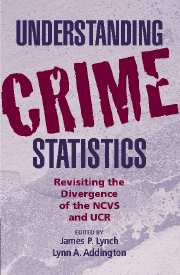Book contents
- Frontmatter
- Contents
- Acknowledgments
- Contributor Biographies
- INTRODUCTION
- OVERVIEW OF THE TWO NATIONAL MEASURES OF U.S. CRIME
- DEFINING DIVERGENCE AND CONVERGENCE
- SOURCES OF DIVERGENCE IN THE NCVS
- 5 Methodological Change in the NCVS and the Effect on Convergence
- 6 Series Victimizations and Divergence
- 7 Exploring Differences in Estimates of Visits to Emergency Rooms for Injuries from Assaults Using the NCVS and NHAMCS
- SOURCES OF DIVERGENCE IN THE UCR
- CONCLUSION
- Index
- CAMBRIDGE STUDIES IN CRIMINOLOGY
- References
6 - Series Victimizations and Divergence
Published online by Cambridge University Press: 23 December 2009
- Frontmatter
- Contents
- Acknowledgments
- Contributor Biographies
- INTRODUCTION
- OVERVIEW OF THE TWO NATIONAL MEASURES OF U.S. CRIME
- DEFINING DIVERGENCE AND CONVERGENCE
- SOURCES OF DIVERGENCE IN THE NCVS
- 5 Methodological Change in the NCVS and the Effect on Convergence
- 6 Series Victimizations and Divergence
- 7 Exploring Differences in Estimates of Visits to Emergency Rooms for Injuries from Assaults Using the NCVS and NHAMCS
- SOURCES OF DIVERGENCE IN THE UCR
- CONCLUSION
- Index
- CAMBRIDGE STUDIES IN CRIMINOLOGY
- References
Summary
Divergence between annual estimates of crime produced by the Uniform Crime Reports (UCR) and National Crime Victimization Survey (NCVS) may be explained, in part, by the way criminal events are classified and counted. One important type of criminal phenomenon, the repeat victim, poses a particularly challenging problem for victimization surveys. Although the definition has been operationalized in a variety of ways, the common denominator in these various definitions is one common factor: a person experiences more than one victimization in a given time period (Farrell, 1995; Pease, 1998). This is important because, unlike official police records that are often produced immediately after or within a few days of a criminal offense, the NCVS “survey method is heavily dependent upon the ability and motivation of the respondent to remember events and report them in the interview situation” (Biderman et al., 1967). Although recall accuracy is a cognitive task for all victims to some degree, it is especially difficult for the repeat victim. They must not only remember and report details of numerous crime events, but they also must not confuse aspects of different events and even treat continuous events as if they were discrete. This is a considerable burden.
To accommodate the high-volume or chronic victim who could report dozens if not hundreds of victimizations, the NCVS developed a process that classifies six or more “similar” victimizations as a series incident (see Chapter 2, this volume).
- Type
- Chapter
- Information
- Understanding Crime StatisticsRevisiting the Divergence of the NCVS and the UCR, pp. 156 - 182Publisher: Cambridge University PressPrint publication year: 2006
References
- 1
- Cited by



